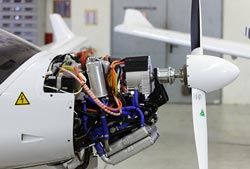Le Bourget: Electric Hybrid Drives for Aircraft

The airplane is powered by a hybrid system comprising an integrated drive system from Siemens and a generator fed by a small rotary engine.<br><br>The DA36 E-Star 2's Integrated Drive System is characterized by its compactness and low weight. Its specific continuous output is 5 kW/kg.<br>
The two-seat DA36 E-Star 2 plane recently made its one-hour maiden flight and was then presented to aeronautics experts at the Paris Air Show. The electric series hybrid drive ensures quiet and energy-efficient operation.
After a predecessor model had demonstrated in 2011 that electric series hybrid drives are, in principle, suited for aircraft, the plane's second generation proves that the technology is also appropriate for commercial use.
Siemens, EADS, and Diamond Aircraft have been working for some years on this drive technology, which can reduce fuel consumption and emissions by around one fourth. The propeller is powered by an electric motor with 65 kilowatts of continuous output. The electricity is supplied through a generator by a small Wankel engine that consumes little fuel, because it runs evenly at a low output.
An EADS battery provides the plane with the energy it needs for take-off. The battery is recharged when the plane is cruising. Converters from Siemens supply the electric motor with power from the battery and the generator. The airplane takes off electrically – in other words, quietly and fuel-efficiently – and it has a sufficiently long range.
To power the plane, Siemens developed a new integrated drive system in which all of the components are optimally coordinated with one another. The hybrid drive is around 100 kilograms (kg) lighter than that of the predecessor model of 2011. The new aircraft's motor generates around five times as much output per kilogram as conventional drive systems. Siemens' global research organization Corporate Technology (CT) develops electric aircraft motors with very high power densities. In the future, these motors will also feature high-temperature superconductivity. CT was also responsible for the new plane's system integration and developed the control unit, which implements the pilot's commands for the batteries and the drivetrain.
The plane's passenger capacity and range make it a realistic option for commercial use. In addition, the drive system has a scalable output and can be expanded to power planes for 50 to 100 passengers. Today airlines spend one third of their operating costs on fuel. According to the Intergovernmental Panel on Climate Change (IPCC), aviation currently accounts for two percent of global carbon dioxide emissions. Siemens and EADS have now formed a long-term research partnership with Diamond Aircraft. The partners aim to introduce hybrid drive systems into helicopters, small planes, and commercial passenger aircraft. The system should achieve type certification in the general aviation category in three to five years.
Media Contact
More Information:
http://www.siemens.com/innovationnewsAll latest news from the category: Power and Electrical Engineering
This topic covers issues related to energy generation, conversion, transportation and consumption and how the industry is addressing the challenge of energy efficiency in general.
innovations-report provides in-depth and informative reports and articles on subjects ranging from wind energy, fuel cell technology, solar energy, geothermal energy, petroleum, gas, nuclear engineering, alternative energy and energy efficiency to fusion, hydrogen and superconductor technologies.
Newest articles

Silicon Carbide Innovation Alliance to drive industrial-scale semiconductor work
Known for its ability to withstand extreme environments and high voltages, silicon carbide (SiC) is a semiconducting material made up of silicon and carbon atoms arranged into crystals that is…

New SPECT/CT technique shows impressive biomarker identification
…offers increased access for prostate cancer patients. A novel SPECT/CT acquisition method can accurately detect radiopharmaceutical biodistribution in a convenient manner for prostate cancer patients, opening the door for more…

How 3D printers can give robots a soft touch
Soft skin coverings and touch sensors have emerged as a promising feature for robots that are both safer and more intuitive for human interaction, but they are expensive and difficult…





















